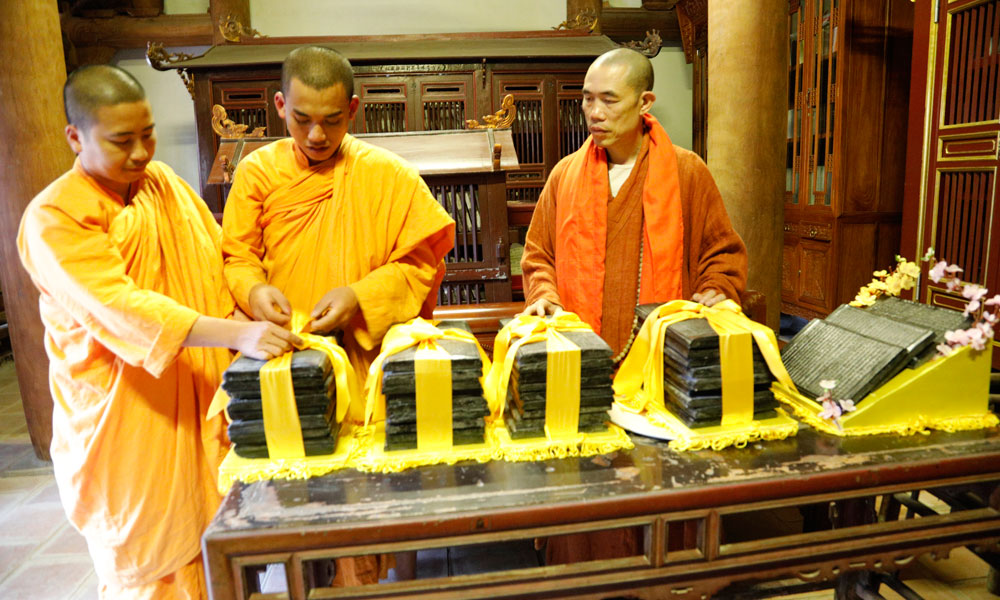Ca tru singing in Phuong Hoang land
The more they learn, the more they love
Chan recalled that in the early days when the club was just establishment in 2009, there were only more than 10 participants, most of them were elderly. She was the first person to set up the club. However, not everyone can sing Ca tru because it is the perfect and peak combination between poetry and music, a scholarly art.
 |
|
A practising session of the Yen Dung district Ca Tru Club at the Ba Tong communal house. |
If people are not passionate, learn hard and master techniques, they will not follow this career. Normally, a Ca tru performance involves three performers: the female vocalist plays phach (small wooden sticks beaten on a small bamboo bar to serve as percussion); the man plays dan day (a long-necked, 3-string lute used almost exclusively for Ca tru performance); and the spectator (often a scholar or connoisseur of the art) strikes a trong chau (praise drum) in praise (or disapproval) of the singer's performance.
In order to overcome the initial difficulties, apart from self-learning through video discs, the club also sent members to attend Ca tru singing classes organized by the provincial Department of Culture, Sports and Tourism, and then taught everyone.
The club members were mainly from Neo township and Canh Thuy, Tu Mai, Xuan Phu and Nham Son communes as well as from different backgrounds and occupations such as farmer, trader, retired teacher and doctor. Some children also followed their grandmothers and mothers to see Ca tru performances and join the club.
Funding for Ca tru singing activities was limited and most of the costumes and musical instruments were bought by the members themselves, but the club has been operating steadily over the past 10 years. Ong Thi Thu Hoai, (64 years old) in Nhat village, Canh Thuy commune - a retired teacher has joined the Ca Tru Club of the district for 10 years.
At the beginning, she did not remember the words and phach percussions. Thanks to the tutoring and guidance of the artisans as well as the practice via listening discs and watching tapes and the Internet, now Hoai can sing many difficult songs well.
Currently, Hoai is Chairwoman of the Yen Dung district Ca tru Club. Not only being an active member of the club, she also inspires some local students, including her granddaughter Ong Ha Thao Chi (10 years old). Chi has been taught Ca tru by her grandmother since she was 4 years old. Now she can remember and sing many Ca tru songs.
Preserving heritage
According to cultural researchers, Ca tru used to be loved by kings and mandarins. It was popular in the folk and named as one of the customs in the regulations of villages and associations...
Bac Giang is one of the localities where Ca tru appeared early (around the 16th century). Experiencing the ups and downs of history, there were periods when this type of art fell into oblivion.
Since 2009, when Ca tru was inscribed by UNESCO in the list of intangible cultural heritage in need of urgent safeguarding, this type of art has received Yen Dung district’s attention. In addition to maintaining regular activities, the club members have actively participated in many festivals of the district and the province, and won high prizes with dozens of unique performances.
Ta Hai Nam, Deputy Director of the Yen Dung district Center for Culture, Information and Sports, said in the coming time, the unit will actively coordinate with People's Committees of communes and townships in the district to promote Ca tru performing activities through exchanges, competitions, and festivals to find and discover potential vocalists and then training them to become core singers for movements at the grassroots level.
It will propose the district People's Committee support money for the club to buy costumes, props and musical instruments in order to help the club work better.
With the attention of the district authorities and relevant agencies, it is hoped that this unique folk art form will survive in the Phuong Hoang land, contributing to enriching the spiritual and cultural life in the community as well as preserving and promoting the value of the UNESCO-recognized heritage.
Cong Doanh
 Bắc giang
Bắc giang















Reader's comments (0)